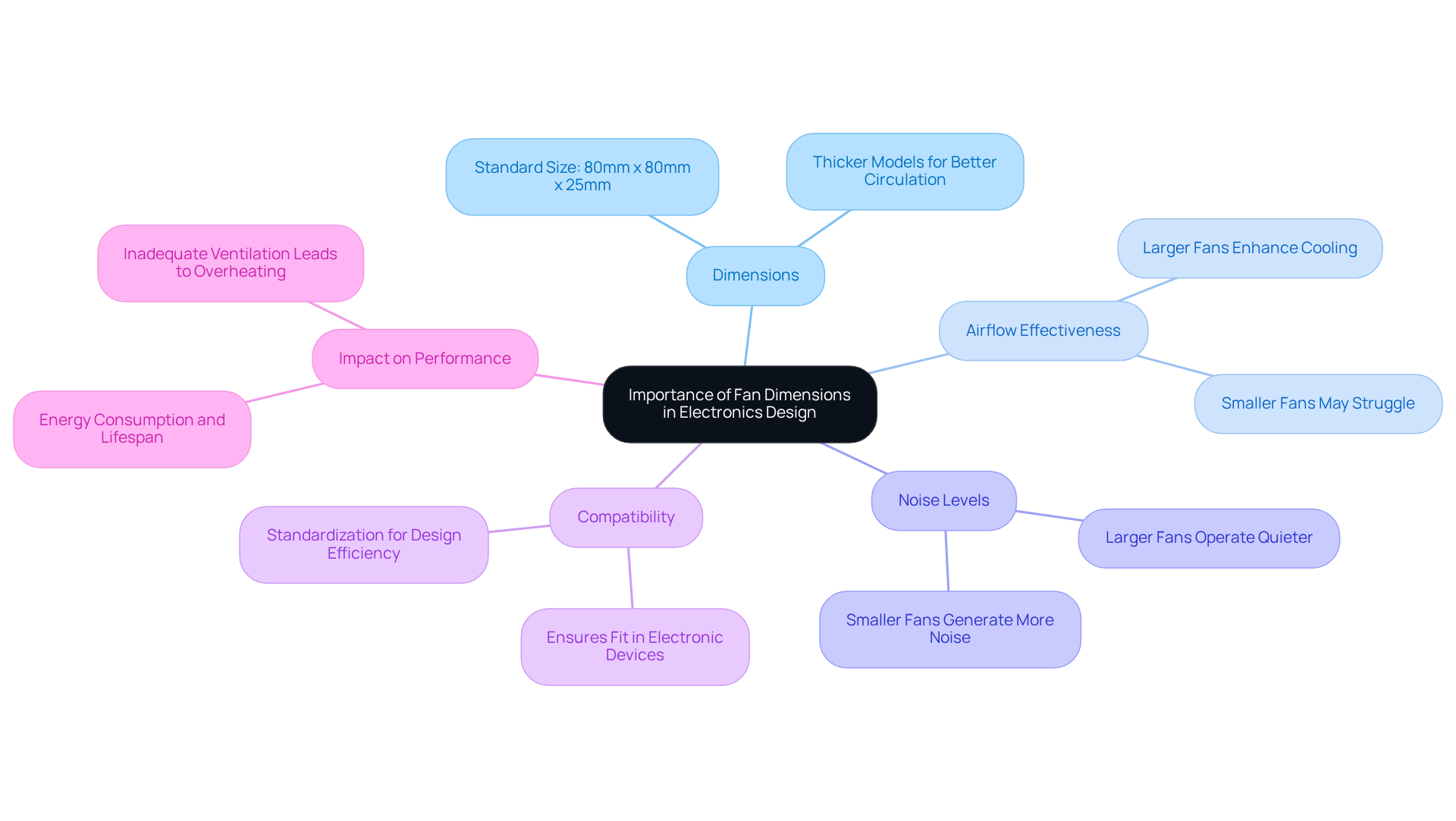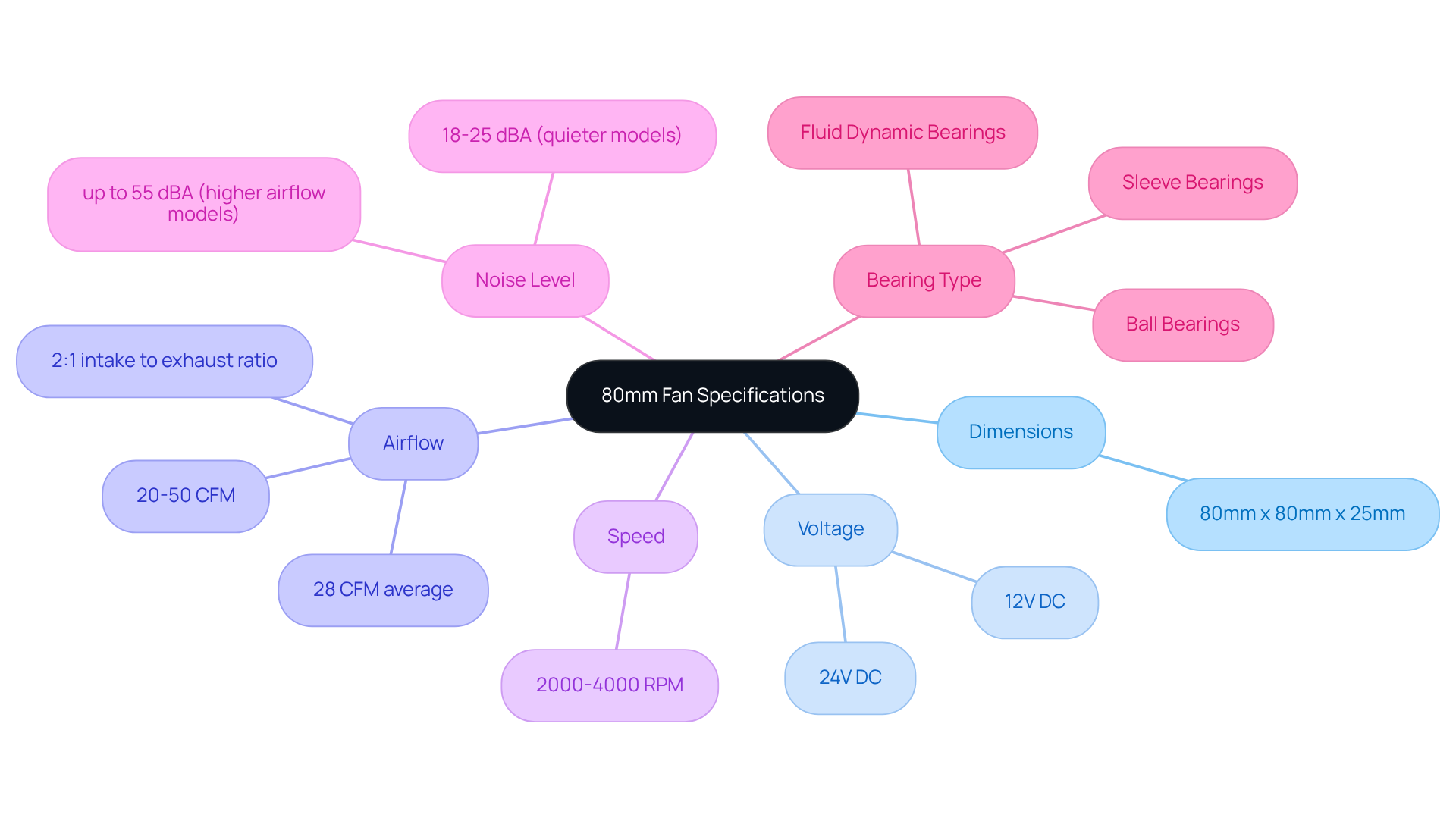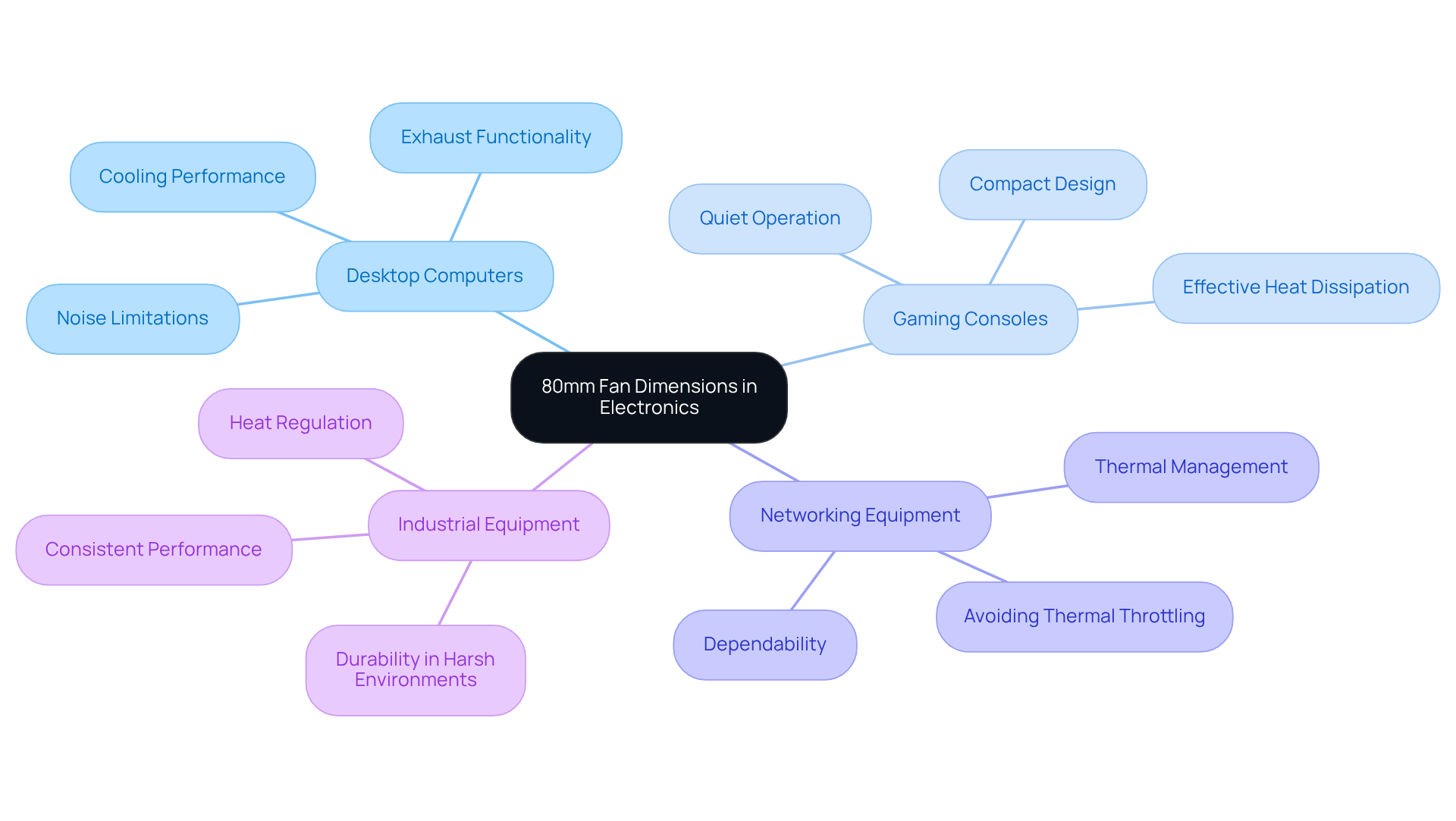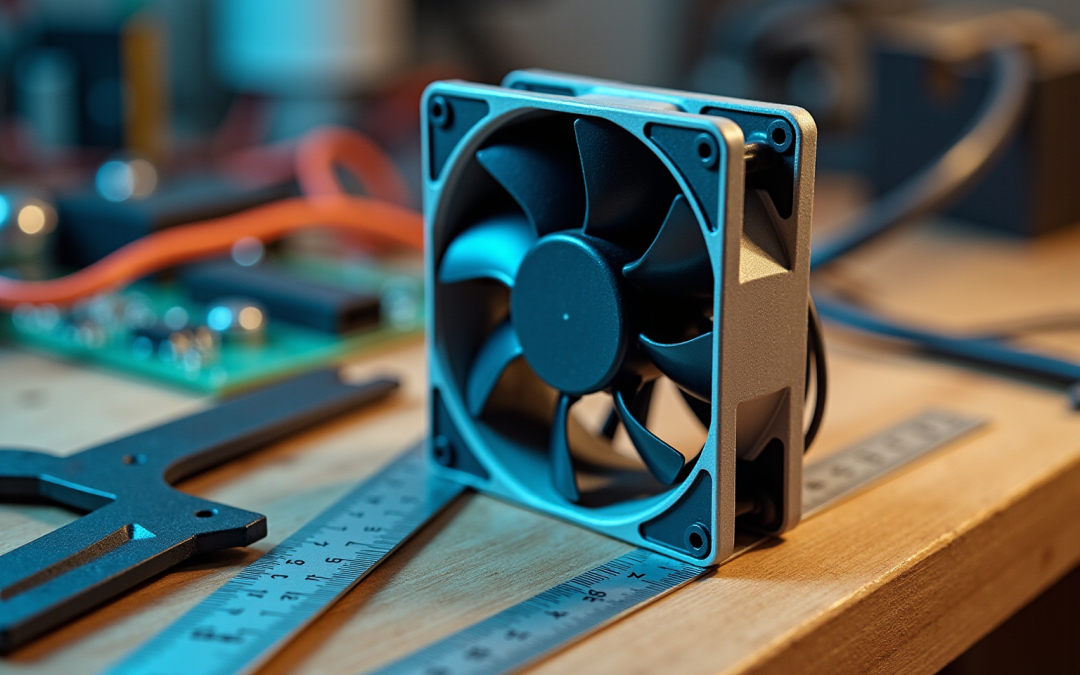Overview
The article highlights the critical importance of 80mm fan dimensions, standardized at 80mm x 80mm x 25mm, in the realm of effective electronics design and thermal management. Understanding these dimensions is essential for ensuring compatibility and achieving optimal cooling performance across various applications. Properly sized fans not only enhance airflow but also significantly reduce noise levels, which plays a vital role in preventing overheating and extending the lifespan of electronic components.
Incorporating 80mm fans into designs allows engineers to address common thermal challenges effectively. By selecting appropriately sized fans, one can ensure that electronic devices operate within their ideal temperature ranges, thereby enhancing reliability and performance. The implications of fan dimensions extend beyond mere size; they are integral to the overall functionality and durability of electronic systems.
Ultimately, the adoption of standardized fan dimensions is a strategic move that can lead to improved product performance and customer satisfaction. Engineers and designers are encouraged to prioritize these specifications in their projects to optimize thermal management solutions.
Introduction
Understanding the dimensions of cooling fans is crucial for effective electronics design, particularly regarding the widely used 80mm models. These standardized specifications dictate compatibility within devices and significantly influence airflow and cooling efficiency, which are vital for maintaining optimal operating temperatures in electronic components. The impact of these seemingly simple measurements on the performance and longevity of complex systems cannot be underestimated.
This article delves into the importance of 80mm fan dimensions, exploring their specifications and real-world applications, uncovering the key factors that engineers must consider to prevent overheating and enhance device reliability.
Clarify Fan Dimensions and Their Importance in Electronics Design
The dimensions for cooling devices, particularly for 80mm models, are standardized at 80mm fan dimensions of 80mm x 80mm x 25mm (3.15″ x 3.15″ x 0.984″). These specifications are critical for ensuring compatibility within electronic devices.
Adequately sized blowers can significantly affect ventilation rates and cooling effectiveness, which are essential for sustaining ideal operating temperatures in electronic components. For instance, larger ventilators typically move more air at reduced speeds, thereby enhancing cooling effectiveness while minimizing noise. Conversely, smaller devices may struggle to generate the same level of circulation, potentially leading to overheating issues.
Furthermore, the density of the device plays a crucial role; thicker models often provide greater circulation under specific conditions, making them suitable for applications requiring robust cooling solutions. Engineers must meticulously evaluate the 80mm fan dimensions when designing enclosures to prevent overheating and ensure reliable performance, since inadequate ventilation can lead to increased energy consumption and a reduced lifespan of components.

Explore Standard Measurements and Specifications of 80mm Fans
Standard specifications for 80mm fans typically encompass several critical aspects:
- Dimensions: Measuring 80mm x 80mm x 25mm, these fans are compact yet effective for a variety of applications.
- Voltage: They are most commonly available in 12V DC, with some models also supporting 24V DC, providing flexibility in design.
- Airflow: Airflow rates generally range from 20 to 50 CFM (Cubic Feet per Minute), with average performance metrics indicating that 28 CFM is suitable for most setups, particularly in low-noise environments. For optimal cooling, achieving a 2:1 intake to exhaust air ratio is advisable, which can be supported by selecting fans with appropriate air movement ratings and voltage specifications.
- Speed: RPM (Revolutions Per Minute) can vary significantly, typically ranging from 2000 to 4000 RPM, influencing both ventilation and noise levels.
- Noise Level: Quieter models operate around 18-25 dBA, making them ideal for noise-sensitive applications, while higher airflow models may reach up to 55 dBA.
- Bearing Type: Options include sleeve, ball, and fluid dynamic bearings, each affecting the fan’s longevity and operational noise.
Gagner-Toomey Associates stands out as the world’s largest producer of standard and custom air-movers, offering a comprehensive range of DC input Tube Axial devices and Centrifugal Blowers, alongside other innovative cooling solutions. Understanding the 80mm fan dimensions is vital for engineers to align fan performance with the thermal management requirements of their electronic systems. Additionally, the new ARCTIC motor, designed with a four times longer service life due to its low coil temperature, comes with an extended warranty of 6 years, further ensuring reliability in cooling solutions. This warranty reinforces Gagner-Toomey’s commitment to delivering dependable products that meet the rigorous demands of modern electronics.

Apply 80mm Fan Dimensions in Real-World Electronics Applications
In real-world applications, 80mm fans are widely utilized in several critical areas:
- Desktop Computers: Typically installed as exhaust fans, they effectively expel hot air from the case, significantly improving overall cooling performance. This is crucial for maintaining optimal temperatures, especially in high-performance setups.
- Gaming Consoles: These fans are incorporated into compact designs where space is limited, ensuring effective heat dissipation. Their ability to operate quietly while providing adequate airflow is essential for an immersive gaming experience, as they maintain good acoustics while delivering airflow performance.
- Networking Equipment: In routers and switches, cooling devices are crucial for sustaining ideal operating temperatures, avoiding thermal throttling that can reduce performance and dependability.
- Industrial Equipment: Utilized in control panels and enclosures, fans of 80 millimeters regulate heat produced by electronic components, guaranteeing consistent performance in challenging environments.
The 80mm fan dimensions provide a useful balance between compact design and effective air movement, making it suitable for various applications. When choosing an 80mm fan dimensions for these applications, engineers must consider both the dimensions and the ventilation specifications along with noise limitations. For instance, gaming consoles may prioritize quieter operation to improve user experience, while industrial uses often concentrate on maximizing airflow to avoid overheating. By understanding the specific needs of each application, engineers can select the most suitable fan, thereby enhancing performance and reliability across diverse electronic systems. The global Computer Fan Market is projected to reach approximately USD 4.82 Billion by 2033, highlighting the growing relevance and demand for 80mm fan dimensions in the industry.

Conclusion
Understanding the significance of 80mm fan dimensions is crucial for effective electronics design. These standardized measurements not only ensure compatibility within devices but also play a pivotal role in maintaining optimal operating temperatures. The right fan dimensions can lead to improved airflow, reduced noise, and overall enhanced performance in various electronic applications.
Key insights regarding the specifications and real-world applications of 80mm fans reveal their critical dimensions and airflow rates, as well as their integration into desktop computers, gaming consoles, and industrial equipment. It is evident that these fans are integral to ensuring reliable thermal management. Selecting the appropriate fan based on specific application needs is essential, as it can significantly impact device performance and longevity.
As the demand for efficient cooling solutions continues to rise, the relevance of understanding 80mm fan dimensions cannot be overstated. Engineers and designers are encouraged to prioritize these specifications in their projects to optimize performance and reliability. By making informed choices about fan dimensions and their applications, the potential for innovation in electronics design is vast, paving the way for more efficient and sustainable technologies.
Frequently Asked Questions
What are the standard dimensions for 80mm fans?
The standard dimensions for 80mm fans are 80mm x 80mm x 25mm (3.15″ x 3.15″ x 0.984″).
Why are fan dimensions important in electronics design?
Fan dimensions are critical for ensuring compatibility within electronic devices and for maintaining effective ventilation and cooling, which are essential for sustaining ideal operating temperatures in electronic components.
How do fan size and design affect cooling effectiveness?
Larger fans typically move more air at reduced speeds, enhancing cooling effectiveness while minimizing noise. Smaller fans may struggle to generate the same level of air circulation, potentially leading to overheating issues.
What role does the density of a fan play in cooling?
The density of the fan affects circulation; thicker models often provide greater air circulation under specific conditions, making them suitable for applications that require robust cooling solutions.
What should engineers consider when designing enclosures for electronic devices?
Engineers must meticulously evaluate the 80mm fan dimensions to prevent overheating and ensure reliable performance, as inadequate ventilation can lead to increased energy consumption and a reduced lifespan of components.

